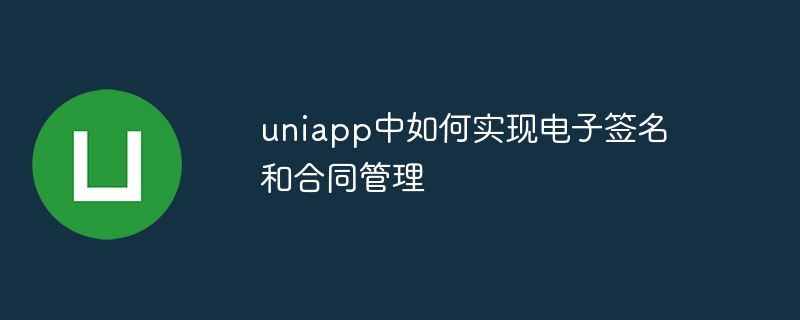

Title: How to implement electronic signature and contract management in Uniapp
Introduction:
With the continuous advancement of technology, electronic signature and contract management are becoming more and more important in modern society. is becoming more and more important. In mobile application development, Uniapp, as a cross-platform framework, provides many convenient functions and tools to help developers implement electronic signature and contract management functions. This article will introduce how to implement electronic signature and contract management in Uniapp and provide specific code examples.
1. Implementation of electronic signature function
Add plug-in
Add plug-in reference under the "easycom" node in uniapp's pages.json file. The sample code is as follows:
"easycom": {
"autoscan": true,
"custom": {
"^vue-signature-pad/.*$": "vue-signature-pad"
}
}Create Signature page
Create a signature page under the pages folder in the Uniapp project. The sample code is as follows:
<template>
<div>
<signature-pad v-model="signatureData" ref="signaturePad"></signature-pad>
<button @click="saveSignature">保存</button>
</div>
</template>
<script>
export default {
data() {
return {
signatureData: null
}
},
methods: {
saveSignature() {
// 将签名数据保存到数据库或服务器
console.log(this.signatureData);
}
}
}
</script>Use the signature component
In the page that needs to use the signature function , jump to the signature page through the navigation of uniapp, and pass the signature data to the signature page. The sample code is as follows:
<template>
<div>
<button @click="gotoSignaturePage">进入签名页面</button>
</div>
</template>
<script>
export default {
methods: {
gotoSignaturePage() {
uni.navigateTo({
url: '/pages/signature/signature?signatureData=' + this.signatureData
});
}
}
}
</script>Through the above steps, we can implement electronic signature in Uniapp Function.
2. Implementation of contract management
Create a contract page
Create a contract page under the pages folder in the Uniapp project to display the contract list and Contract details. The sample code is as follows:
<template>
<div>
<ul>
<li v-for="contract in contractList" :key="contract.id">
<span>{{contract.title}}</span>
<button @click="gotoContractDetail(contract.id)">查看详情</button>
</li>
</ul>
</div>
</template>
<script>
export default {
data() {
return {
contractList: []
}
},
mounted() {
// 从数据库或服务器获取合同列表数据
this.getContractList();
},
methods: {
getContractList() {
// 发起网络请求,获取合同列表数据
// 将获取到的数据赋值给contractList
},
gotoContractDetail(contractId) {
uni.navigateTo({
url: '/pages/contractDetail/contractDetail?contractId=' + contractId
});
}
}
}
</script>Create a contract details page
Create a contract details page under the pages folder in the Uniapp project to display the specific content of the contract. The sample code is as follows:
<template>
<div>
<h1>{{contract.title}}</h1>
<p>{{contract.content}}</p>
</div>
</template>
<script>
export default {
data() {
return {
contract: {}
}
},
mounted() {
// 从数据库或服务器获取合同详情数据
this.getContractDetail();
},
methods: {
getContractDetail() {
// 发起网络请求,获取合同详情数据
// 将获取到的数据赋值给contract
}
}
}
</script>Through the above steps, we can implement the contract management function in Uniapp.
Conclusion:
In Uniapp, we can flexibly utilize the functions and tools of uniapp to implement electronic signature and contract management functions by introducing appropriate plug-ins and using corresponding components. The code examples provided above can provide developers with a basic implementation solution, which can be modified and expanded according to specific needs to meet the requirements of actual projects. Wish everyone good luck with development!
The above is the detailed content of How to implement electronic signature and contract management in uniapp. For more information, please follow other related articles on the PHP Chinese website!




